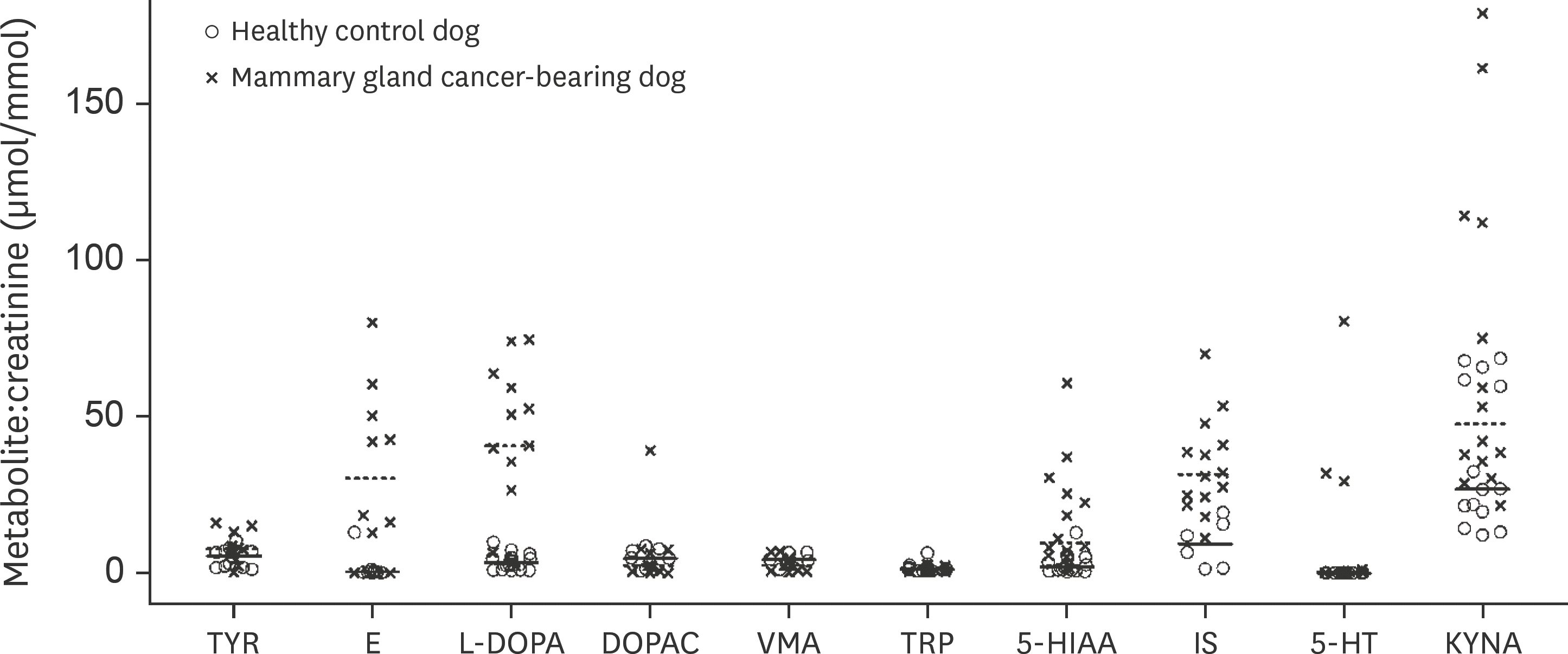1. Peña L, Gama A, Goldschmidt MH, Abadie J, Benazzi C, Castagnaro M, Díez L, Gärtner F, Hellmén E, Kiupel M, Millán Y, Miller MA, Nguyen F, Poli A, Sarli G, Zappulli V, de las Mulas JM. Canine mammary tumors: a review and consensus of standard guidelines on epithelial and myoepithelial phenotype markers, HER2, and hormone receptor assessment using immunohistochemistry. Vet Pathol. 2014; 51:127–145.
2. Sorenmo K. Canine mammary gland tumors. Vet Clin North Am Small Anim Pract. 2003; 33:573–596.

3. Concannon PW, Spraker TR, Casey HW, Hansel W. Gross and histopathologic effects of medroxyprogesterone acetate and progesterone on the mammary glands of adult beagle bitches. Fertil Steril. 1981; 36:373–387.

4. Sorenmo KU, Kristiansen VM, Cofone MA, Shofer FS, Breen AM, Langeland M, Mongil CM, Grondahl AM, Teige J, Goldschmidt MH. Canine mammary gland tumours; a histological continuum from benign to malignant; clinical and histopathological evidence. Vet Comp Oncol. 2009; 7:162–172.

5. Moe L. Population-based incidence of mammary tumours in some dog breeds. J Reprod Fertil Suppl. 2001; 57:439–443.
6. Nguyen F, Peña L, Ibisch C, Loussouarn D, Gama A, Rieder N, Belousov A, Campone M, Abadie J. Canine invasive mammary carcinomas as models of human breast cancer. Part 1: natural history and prognostic factors. Breast Cancer Res Treat. 2018; 167:635–648.

7. Johnson CH, Manna SK, Krausz KW, Bonzo JA, Divelbiss RD, Hollingshead MG, Gonzalez FJ. Global metabolomics reveals urinary biomarkers of breast cancer in a mcf-7 xenograft mouse model. Metabolites. 2013; 3:658–672.

8. Wu G. Amino acids: metabolism, functions, and nutrition. Amino Acids. 2009; 37:1–17.

9. Wiggins T, Kumar S, Markar SR, Antonowicz S, Hanna GB. Tyrosine, phenylalanine, and tryptophan in gastroesophageal malignancy: a systematic review. Cancer Epidemiol Biomarkers Prev. 2015; 24:32–38.

10. Oto J, Suzue A, Inui D, Fukuta Y, Hosotsubo K, Torii M, Nagahiro S, Nishimura M. Plasma proinflammatory and anti-inflammatory cytokine and catecholamine concentrations as predictors of neurological outcome in acute stroke patients. J Anesth. 2008; 22:207–212.

11. Heng B, Lim CK, Lovejoy DB, Bessede A, Gluch L, Guillemin GJ. Understanding the role of the kynurenine pathway in human breast cancer immunobiology. Oncotarget. 2016; 7:6506–6520.

12. Kuo TR, Chen JS, Chiu YC, Tsai CY, Hu CC, Chen CC. Quantitative analysis of multiple urinary biomarkers of carcinoid tumors through gold-nanoparticle-assisted laser desorption/ionization time-of-flight mass spectrometry. Anal Chim Acta. 2011; 699:81–86.

13. Chung KT, Gadupudi GS. Possible roles of excess tryptophan metabolites in cancer. Environ Mol Mutagen. 2011; 52:81–104.

14. Mulder EJ, Anderson GM, Kemperman RF, Oosterloo-Duinkerken A, Minderaa RB, Kema IP. Urinary excretion of 5-hydroxyindoleacetic acid, serotonin and 6-sulphatoxymelatonin in normoserotonemic and hyperserotonemic autistic individuals. Neuropsychobiology. 2010; 61:27–32.

15. Porto-Figueira P, Pereira JA, Câmara JS. Exploring the potential of needle trap microextraction combined with chromatographic and statistical data to discriminate different types of cancer based on urinary volatomic biosignature. Anal Chim Acta. 2018; 1023:53–63.

16. Chen Y, Zhang R, Song Y, He J, Sun J, Bai J, An Z, Dong L, Zhan Q, Abliz Z. RRLC-MS/MS-based metabonomics combined with in-depth analysis of metabolic correlation network: finding potential biomarkers for breast cancer. Analyst (Lond). 2009; 134:2003–2011.

17. Cascino A, Cangiano C, Ceci F, Franchi F, Mineo T, Mulieri M, Muscaritoli M, Rossi Fanelli F. Increased plasma free tryptophan levels in human cancer: a tumor related effect? Anticancer Res. 1991; 11:1313–1316.
18. Valko-Rokytovská M, Očenáš P, Salayová A, Kostecká Z. New developed UHPLC method for selected urine metabolites. J Chromatogr Sep Tech. 2018; 9:1000404.

19. Nam H, Chung BC, Kim Y, Lee K, Lee D. Combining tissue transcriptomics and urine metabolomics for breast cancer biomarker identification. Bioinformatics. 2009; 25:3151–3157.

20. Mishra P, Ambs S. Metabolic signatures of human breast cancer. Mol Cell Oncol. 2015; 2:e992217.

21. Prendergast GC. Cancer: why tumours eat tryptophan. Nature. 2011; 478:192–194.
22. Jose J, Tavares CD, Ebelt ND, Lodi A, Edupuganti R, Xie X, Devkota AK, Kaoud TS, Van Den Berg CL, Anslyn EV, Tiziani S, Bartholomeusz C, Dalby KN. Serotonin analogues as inhibitors of breast cancer cell growth. ACS Med Chem Lett. 2017; 8:1072–1076.

23. Miller AG, Brown H, Degg T, Allen K, Keevil BG. Measurement of plasma 5-hydroxyindole acetic acid by liquid chromatography tandem mass spectrometry–comparison with HPLC methodology. J Chromatogr B Analyt Technol Biomed Life Sci. 2010; 878:695–699.

24. Yamaguchi J, Tanaka T, Inagi R. Effect of AST-120 in chronic kidney disease treatment: still a controversy? Nephron. 2017; 135:201–206.
25. Sagan D, Kocki T, Patel S, Kocki J. Utility of kynurenic acid for non-invasive detection of metastatic spread to lymph nodes in non-small cell lung cancer. Int J Med Sci. 2015; 12:146–153.

26. Xie Z, Lorkiewicz P, Riggs DW, Bhatnagar A, Srivastava S. Comprehensive, robust, and sensitive UPLC-MS/MS analysis of free biogenic monoamines and their metabolites in urine. J Chromatogr B Analyt Technol Biomed Life Sci. 2018; 1099:83–91.

27. Muthuswamy R, Okada NJ, Jenkins FJ, McGuire K, McAuliffe PF, Zeh HJ, Bartlett DL, Wallace C, Watkins S, Henning JD, Bovbjerg DH, Kalinski P. Epinephrine promotes COX-2-dependent immune suppression in myeloid cells and cancer tissues. Brain Behav Immun. 2017; 62:78–86.

28. Barollo S, Bertazza L, Watutantrige-Fernando S, Censi S, Cavedon E, Galuppini F, Pennelli G, Fassina A, Citton M, Rubin B, Pezzani R, Benna C, Opocher G, Iacobone M, Mian C. Overexpression of L-Type amino acid transporter 1 (LAT1) and 2 (LAT2): Novel markers of neuroendocrine tumors. PLoS One. 2016; 11:e0156044.

29. Zhang A, Sun H, Wang P, Han Y, Wang X. Recent and potential developments of biofluid analyses in metabolomics. J Proteomics. 2012; 75:1079–1088.

30. McCartney A, Vignoli A, Biganzoli L, Love R, Tenori L, Luchinat C, Di Leo A. Metabolomics in breast cancer: a decade in review. Cancer Treat Rev. 2018; 67:88–96.






 PDF
PDF Citation
Citation Print
Print


 XML Download
XML Download